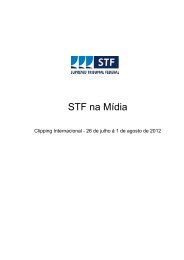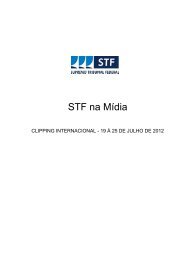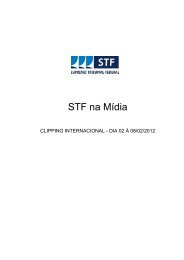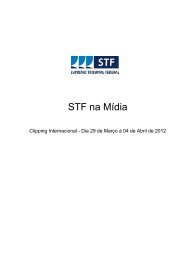- Page 1 and 2:
STF na Mídia Clipping Internaciona
- Page 3 and 4:
Quinta-feira, 19 de Abril de 2012
- Page 5 and 6:
Corriere Della Será/ - Economia,
- Page 7 and 8:
Frankfurter Allgemeine Zeitung/ -
- Page 9 and 10:
Der Gesetzgeber hat demnach seinen
- Page 11 and 12:
Reuters General/ - Article, Qui,
- Page 13 and 14:
Reuters General/ - Article, Qui,
- Page 15 and 16:
Reuters General/ - Article, Qui,
- Page 17 and 18:
Reuters General/ - Article, Qui,
- Page 19 and 20:
Süddeutsche Zeitung/ - Politik,
- Page 21 and 22:
former Gov. David A. Paterson, a De
- Page 23 and 24:
The New York Times/ - Arts, Qui,
- Page 25 and 26:
The New York Times/ - N.Y./Region
- Page 27 and 28:
him better — than Johnson knew or
- Page 29 and 30:
You’ve been writing under the bel
- Page 31 and 32:
the Johnson presidency, which take
- Page 33 and 34:
Quinta-feira, 19 de Abril de 2012
- Page 35 and 36:
Diário de Notícias Lisboa/ - Gl
- Page 37 and 38:
Expresso OnLine Lisboa / - Atuali
- Page 39 and 40:
Reuters General/ - Article, Sex,
- Page 41 and 42:
Reuters General/ - Article, Sex,
- Page 43 and 44:
Reuters General/ - Article, Sex,
- Page 45 and 46:
die psychisch sehr angegriffen ware
- Page 47 and 48:
Süddeutsche Zeitung/ - Politik,
- Page 49 and 50:
a native of Hattiesburg, Miss., wil
- Page 51 and 52:
The New York Times/ - N.Y./Region
- Page 53 and 54:
of African blood and still bars wom
- Page 55 and 56:
Quinta-feira, 19 de Abril de 2012
- Page 57 and 58:
ABC Digital/ - Nacionales, Sáb,
- Page 59 and 60:
Correo Peru/ - Política, Sáb, 1
- Page 61 and 62:
Corriere Della Será/ - Economia,
- Page 63 and 64:
attenzione al suo ruolo, l’ultima
- Page 65 and 66:
Diário de Notícias Lisboa/ - Gl
- Page 67 and 68:
A 24 horas de jugarse el clásico,
- Page 69 and 70:
Frankfurter Allgemeine Zeitung/ -
- Page 71 and 72:
Reuters General/ - Article, Sáb,
- Page 73 and 74:
The Economic Times/ - News, Sáb,
- Page 75 and 76:
The New York Times/ - Politics, S
- Page 77 and 78:
BY the standards of Hilary Rosen, w
- Page 79 and 80:
The New York Times/ - Politics, S
- Page 81 and 82:
parse public opinion, you find the
- Page 83 and 84:
quickly the political tide is turni
- Page 85 and 86:
ON the last night of February, Arth
- Page 87 and 88:
said Arianna Huffington, who saw hi
- Page 89 and 90:
The New York Times/ - Politics, S
- Page 91 and 92:
“Unintentionally, I wound up foll
- Page 93 and 94:
The New York Times/ - The Opinion
- Page 95 and 96:
another son, Akim Shklyaro, 2. "Som
- Page 97 and 98:
Quinta-feira, 19 de Abril de 2012
- Page 99 and 100:
ABC Digital/ - Nacionales, Dom, 1
- Page 101 and 102:
popular resentments about sovereign
- Page 103 and 104:
women such as Governors Martinez of
- Page 105 and 106:
Business Insurance/ - Article, Do
- Page 107 and 108:
Business Line/ - Markets, Dom, 15
- Page 109 and 110:
Expresso OnLine Lisboa / - Atuali
- Page 111 and 112:
mit der leiblichen Tochter aber ver
- Page 113 and 114:
aussehende, perfekt gekleidete, am
- Page 115 and 116:
aucht, ist das der beste Weg in die
- Page 117 and 118:
Los Angeles Times/ - Politics, Do
- Page 119 and 120:
Reuters General/ - Article, Dom,
- Page 121 and 122:
Von Susanne Höll, Berlin Süddeuts
- Page 123 and 124:
USA Today/ - News, Dom, 15 de Abr
- Page 125 and 126:
USA Today/ - News, Dom, 15 de Abr
- Page 127 and 128:
Quinta-feira, 19 de Abril de 2012
- Page 129 and 130:
Quinta-feira, 19 de Abril de 2012
- Page 131 and 132:
Business Line/ - Markets, Seg, 16
- Page 133 and 134:
Correo Del Orinoco/ - Nacionales,
- Page 135 and 136:
Diário de Notícias Lisboa/ - Op
- Page 137 and 138:
El País/ - Internacional, Seg, 1
- Page 139 and 140:
El País/ - Internacional, Seg, 1
- Page 141 and 142:
there is a half-carved ham leg in
- Page 143 and 144:
El Peruano/ - Noticia, Seg, 16 de
- Page 145 and 146:
páginas de la que fui ponente, en
- Page 147 and 148:
El Universal/ - Opinión, Seg, 16
- Page 149 and 150:
La Nacion/ - noticia, Seg, 16 de
- Page 151 and 152:
La Repubblica/ - Cronaca, Seg, 16
- Page 153 and 154:
Le Figaro/ - International, Seg,
- Page 155 and 156:
fondamentaux de l"Ordonnance de 194
- Page 157 and 158:
Reuters General/ - Article, Seg,
- Page 159 and 160:
Süddeutsche Zeitung/ - Politik,
- Page 161 and 162:
Süddeutsche Zeitung/ - Politik,
- Page 163 and 164:
Reuters General/ - Article, Seg,
- Page 165 and 166:
USA Today/ - News, Seg, 16 de Abr
- Page 167 and 168:
USA Today/ - News, Seg, 16 de Abr
- Page 169 and 170:
Shar Anderson oversaw 20 workers in
- Page 171 and 172:
USA Today/ - News, Seg, 16 de Abr
- Page 173 and 174:
Shar Anderson oversaw 20 workers in
- Page 175 and 176:
USA Today/ - News, Seg, 16 de Abr
- Page 177 and 178:
USA Today/ - News, Seg, 16 de Abr
- Page 179 and 180:
Quinta-feira, 19 de Abril de 2012
- Page 181 and 182:
Quinta-feira, 19 de Abril de 2012
- Page 183 and 184:
Bloomberg/ - Politics, Ter, 17 de
- Page 185 and 186:
Letters This refers to the editoria
- Page 187 and 188:
Business Line/ - Markets, Ter, 17
- Page 189 and 190:
Diário de Notícias Lisboa/ - Gl
- Page 191 and 192:
El País/ - Internacional, Ter, 1
- Page 193 and 194:
El Peruano/ - Noticia, Ter, 17 de
- Page 195 and 196:
El Universal/ - Nación, Ter, 17
- Page 197 and 198:
Expresso OnLine Lisboa / - Atuali
- Page 199 and 200:
deshalb zum Scheitern verurteilt. V
- Page 201 and 202:
Quick-freeze-Regelung voraus, d
- Page 203 and 204:
La Nacion/ - noticia, Ter, 17 de
- Page 205 and 206:
La Repubblica/ - Cronaca, Ter, 17
- Page 207 and 208:
Le Monde/ - Article, Ter, 17 de A
- Page 209 and 210:
Reuters General/ - Article, Ter,
- Page 211 and 212: Reuters General/ - Article, Ter,
- Page 213 and 214: Reuters General/ - Article, Ter,
- Page 215 and 216: The Economic Times/ - Politics/Na
- Page 217 and 218: dozen subway lines to the area empt
- Page 219 and 220: was returning $14,500 to the govern
- Page 221 and 222: paid,” she said. In Florida, edit
- Page 223 and 224: USA Today/ - News, Ter, 17 de Abr
- Page 225 and 226: 18/04/2012
- Page 227 and 228: Quinta-feira, 19 de Abril de 2012
- Page 229 and 230: Business Line/ - Markets, Qua, 18
- Page 231 and 232: Diário de Notícias Lisboa/ - Gl
- Page 233 and 234: El Dia/ - Noticia, Qua, 18 de Abr
- Page 235 and 236: El Dia/ - Noticia, Qua, 18 de Abr
- Page 237 and 238: El País/ - Internacional, Qua, 1
- Page 239 and 240: El Universal/ - Nación, Qua, 18
- Page 241 and 242: El Universal/ - Política, Qua, 1
- Page 243 and 244: La Nacion/ - Política, Qua, 18 d
- Page 245 and 246: La perdita dell"olfatto QUANDO il f
- Page 247 and 248: La Repubblica/ - Cronaca, Qua, 18
- Page 249 and 250: Le Figaro/ - économie, Qua, 18 d
- Page 251 and 252: Los Angeles Times/ - Politics, Qu
- Page 253 and 254: Los Angeles Times/ - Politics, Qu
- Page 255 and 256: In den meisten Fällen folgen die E
- Page 257 and 258: The Economic Times/ - News, Qua,
- Page 259 and 260: The Economic Times/ - News, Qua,
- Page 261: The New York Times/ - Politics, Q
- Page 265 and 266: USA Today/ - News, Qua, 18 de Abr
- Page 267: used as ammunition. Still, his madl











